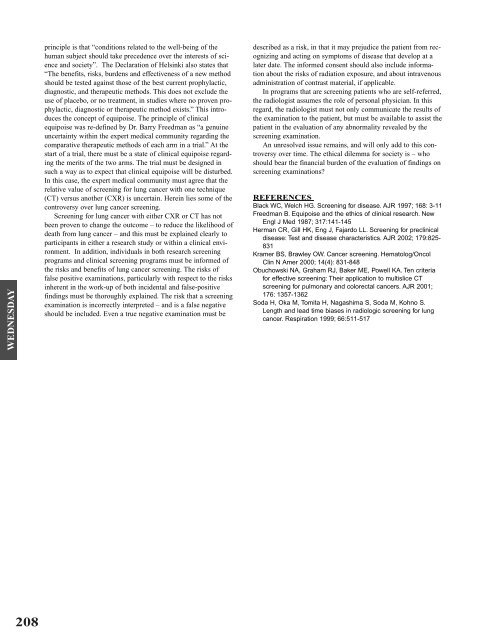Thoracic Imaging 2003 - Society of Thoracic Radiology
Thoracic Imaging 2003 - Society of Thoracic Radiology
Thoracic Imaging 2003 - Society of Thoracic Radiology
You also want an ePaper? Increase the reach of your titles
YUMPU automatically turns print PDFs into web optimized ePapers that Google loves.
WEDNESDAY<br />
208<br />
principle is that “conditions related to the well-being <strong>of</strong> the<br />
human subject should take precedence over the interests <strong>of</strong> science<br />
and society”. The Declaration <strong>of</strong> Helsinki also states that<br />
“The benefits, risks, burdens and effectiveness <strong>of</strong> a new method<br />
should be tested against those <strong>of</strong> the best current prophylactic,<br />
diagnostic, and therapeutic methods. This does not exclude the<br />
use <strong>of</strong> placebo, or no treatment, in studies where no proven prophylactic,<br />
diagnostic or therapeutic method exists.” This introduces<br />
the concept <strong>of</strong> equipoise. The principle <strong>of</strong> clinical<br />
equipoise was re-defined by Dr. Barry Freedman as “a genuine<br />
uncertainty within the expert medical community regarding the<br />
comparative therapeutic methods <strong>of</strong> each arm in a trial.” At the<br />
start <strong>of</strong> a trial, there must be a state <strong>of</strong> clinical equipoise regarding<br />
the merits <strong>of</strong> the two arms. The trial must be designed in<br />
such a way as to expect that clinical equipoise will be disturbed.<br />
In this case, the expert medical community must agree that the<br />
relative value <strong>of</strong> screening for lung cancer with one technique<br />
(CT) versus another (CXR) is uncertain. Herein lies some <strong>of</strong> the<br />
controversy over lung cancer screening.<br />
Screening for lung cancer with either CXR or CT has not<br />
been proven to change the outcome – to reduce the likelihood <strong>of</strong><br />
death from lung cancer – and this must be explained clearly to<br />
participants in either a research study or within a clinical environment.<br />
In addition, individuals in both research screening<br />
programs and clinical screening programs must be informed <strong>of</strong><br />
the risks and benefits <strong>of</strong> lung cancer screening. The risks <strong>of</strong><br />
false positive examinations, particularly with respect to the risks<br />
inherent in the work-up <strong>of</strong> both incidental and false-positive<br />
findings must be thoroughly explained. The risk that a screening<br />
examination is incorrectly interpreted – and is a false negative<br />
should be included. Even a true negative examination must be<br />
described as a risk, in that it may prejudice the patient from recognizing<br />
and acting on symptoms <strong>of</strong> disease that develop at a<br />
later date. The informed consent should also include information<br />
about the risks <strong>of</strong> radiation exposure, and about intravenous<br />
administration <strong>of</strong> contrast material, if applicable.<br />
In programs that are screening patients who are self-referred,<br />
the radiologist assumes the role <strong>of</strong> personal physician. In this<br />
regard, the radiologist must not only communicate the results <strong>of</strong><br />
the examination to the patient, but must be available to assist the<br />
patient in the evaluation <strong>of</strong> any abnormality revealed by the<br />
screening examination.<br />
An unresolved issue remains, and will only add to this controversy<br />
over time. The ethical dilemma for society is – who<br />
should bear the financial burden <strong>of</strong> the evaluation <strong>of</strong> findings on<br />
screening examinations?<br />
REFERENCES<br />
Black WC, Welch HG. Screening for disease. AJR 1997; 168: 3-11<br />
Freedman B. Equipoise and the ethics <strong>of</strong> clinical research. New<br />
Engl J Med 1987; 317:141-145<br />
Herman CR, Gill HK, Eng J, Fajardo LL. Screening for preclinical<br />
disease: Test and disease characteristics. AJR 2002; 179:825-<br />
831<br />
Kramer BS, Brawley OW. Cancer screening. Hematolog/Oncol<br />
Clin N Amer 2000; 14(4): 831-848<br />
Obuchowski NA, Graham RJ, Baker ME, Powell KA. Ten criteria<br />
for effective screening: Their application to multislice CT<br />
screening for pulmonary and colorectal cancers. AJR 2001;<br />
176: 1357-1362<br />
Soda H, Oka M, Tomita H, Nagashima S, Soda M, Kohno S.<br />
Length and lead time biases in radiologic screening for lung<br />
cancer. Respiration 1999; 66:511-517







